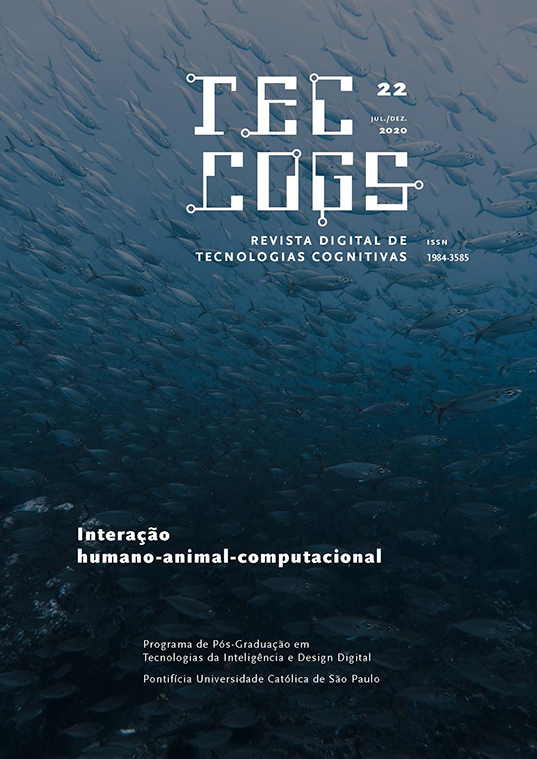Virus semiosis: interview with Kalevi Kull
DOI:
https://doi.org/10.23925/1984-3585.2020i22p13-20Abstract
TECCOGS, Digital Journal of Cognitive Technologies, is pleased to welcome Professor Kalevi Kull, an eminent biosemioticist from the Department of Semiotics at the University of Tartu, Estonia, as a guest to comment on the topic “Virus Semiosis”. This theme seeks to answer whether viruses, such as the coronarivus Covid-19, spread through semiotic processes, that is, through semiosis.
The key to this question lies in the concept of semiosis introduced by Charles S. Peirce in his MS 318 of 1907, but implicit in all his early writings on the essence of signs and their processes. Peirce wrote, “By 'semiosis' I mean […] an action, or influence, which is, or involves, a cooperation between three subjects, being a sign, its object, and its interpretant” (Peirce 1907, p. 411). In other words, a semiosis process begins with a sign, which represents an object, and creates an interpretant, which exerts a semiotic influence with its specific semiotic effect. In this process, signs propagate through a semiotic agency with which they seek a semiotic purpose. The purpose of a symbol, at least, is to propagate, to multiply in the form of other symbols. A symbol that does not propagate dies due to obsolescence, lack of use and intelligibility. In this sense, the symbols seek final causes. They want to be understood. […].
References
BAER, Eugen. Thomas A. Sebeok’s doctrine of signs. In: KRAMPEN, Martin et al., (eds.). Classics of Semiotics. New York, NY: Plenum, p. 181-210, 1987.
KULL, Kalevi. Vegetative, animal, and cultural semiosis: the semiotic threshold zones. Cognitive Semiotics, n. 4, p. 8-27, 2009.
MORRIS, Charles W. Signs, language, and behavior. New York, NY: Prentice-Hall, 1946.
NÖTH, Winfried. O limiar semiótico de Umberto Eco. CooJornal – Revista Rio Total, seção: Opinião Acadêmica, Arquivo (1998). Disponível em: riototal.com.br/coojornal/academicos017.htm. Acesso em: 25 set. 2020.
PEIRCE, Charles S. Pragmatism (MS 318, 1907). In: Peirce, C.S. The Essential Peirce, vol. 2, Peirce Edition Project, (ed.). Bloomington, IN: Indiana University Press, 1998, p. 398-433.
PEIRCE, Charles S. 1931-58. Collected Papers, vols. 1-6. HARTSHORNE, Charles & WEISS, Paul, vols. 7-8, (ed.). Burks, Arthur W. Cambridge, MA: Harvard University Press (CP, vol. & § no.).
SEBEOK, Thomas A. Contributions to the doctrine of signs. Lisse: Peter de
Ridder, 1976.
VILLARREAL, Luis P. Are viruses alive? Scientific American 2008, August 8. Disponível em: scientificamerican.com/article/are-viruses-alive-2004. Acesso em: 25 set. 2020.
Downloads
Published
How to Cite
Issue
Section
License
Copyright (c) 2021 Winfried Nöth; Kalevi Kull; Carlos Eduardo Pires de Camargo

This work is licensed under a Creative Commons Attribution 4.0 International License.
Esta revista oferece acesso livre imediato ao seu conteúdo de acordo com a licença CC BY 4.0, em conformidade com a definição de acesso público do Directory of Open Access Journals (DOAJ).
Ao submeter um texto à TECCOGS, os autores asseguram que o material submetido à avaliação e eventual publicação não infringe de modo algum qualquer direito proprietário ou copyright de outros. Com a submissão, o autor transfere em efetivo os direitos de publicação do artigo para a TECCOGS. A transferência de copyright cobre os direitos exclusivos de publicação e distribuição do artigo, incluindo reimpressões ou quaisquer outras reproduções de natureza similar, além de traduções. Os autores mantém o direito de usar todo ou partes deste texto em trabalhos futuros de sua autoria e de conceder ou recusar a permissão a terceiros para republicar todo ou partes do texto ou de suas traduções. Para republicar números da revista na íntegra, qualquer interessado precisa obter permissão por escrito tanto dos autores como também dos editores da TECCOGS. A TECCOGS por si só pode conceder direitos relativos a emissões de periódicos como um todo.
Imagens com direitos autorais pertencentes a terceiros, que não foram concedidos ao autor do texto, devem ser utilizadas somente quando necessárias à análise e ao argumento da pesquisa, sempre indicando as respectivas fontes e autoria. A TECCOGS dispensa o uso de imagens meramente ilustrativas. Se desejar ilustrar um conceito, o autor deve indicar, em forma de URL ou referência bibliográfica, uma referência em que a ilustração esteja disponível.
---------------------------------------------------------------------------------
This journal offers free immediate access to its content under CC BY 4.0, in accordance with Directory of Open Access Journals' (DOAJ) definition of Open Acess.
When submitting a text to TECCOGS, authors ensure that the material submitted for evaluation and eventual publication does not infringe any proprietary right or copyright. Upon submission, authors effectively transfer the publication rights of the article to TECCOGS. The copyright transfer covers the exclusive rights of publication and distribution of the article, including reprints or any other reproduction of similar nature, in addition to translations. Authors retain the right to use all or parts of the text in future works of their own, as well as to grant or refuse permission to third parties to republish all or parts of the text or its translations. In order to fully republish issues of the magazine, anyone interested must obtain written permission from both the authors and the editors of TECCOGS. TECCOGS alone can grant rights relating to issues of journals as a whole.
Images whose copyright belongs to third parties that have not been granted to the author of the text should be used only when essential for the analysis and argument, always indicating theirs respective sources and authorship. TECCOGS dismisses any use of merely illustrative images. To illustrate a concept, the author must indicate, in the form of a URL or bibliographic reference, a source in which the illustration is available.


